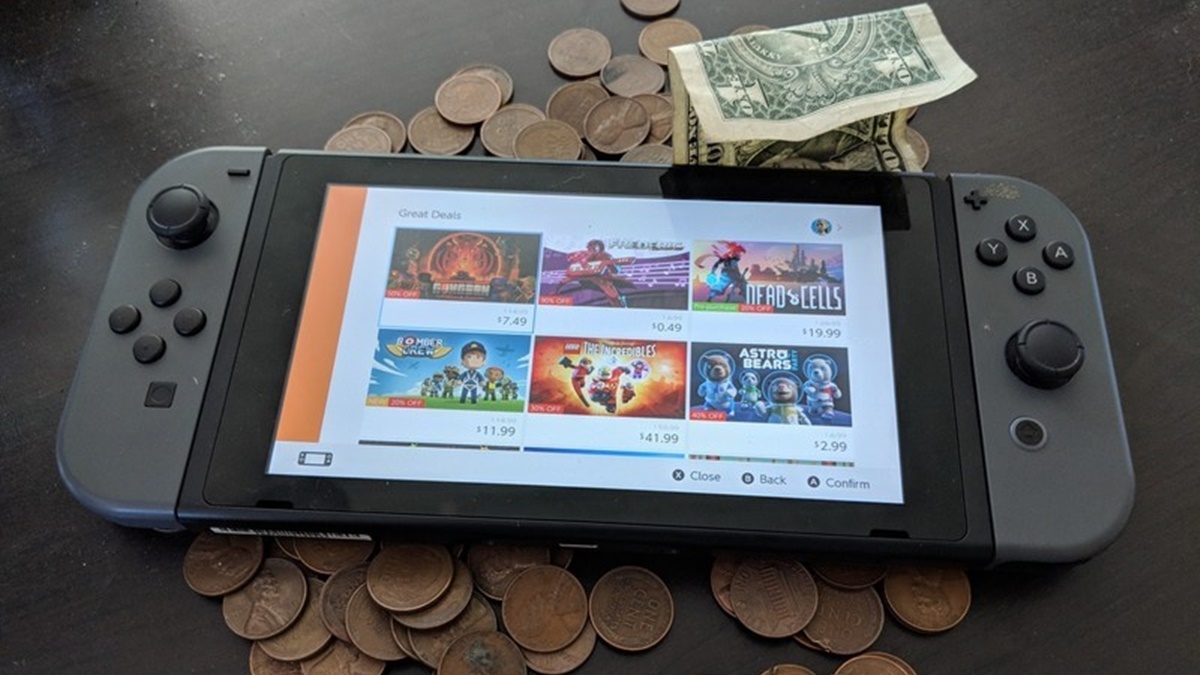
If you are reading this, chances are you loved video games as a child, but you lost your collection at some point.
Maybe it was because you needed to sell them or lost them while moving to a new home.
Or maybe, just like happened to me, your mom gave them away without even asking you!
Whatever the reason, now you are a grown-up, and you remember your old games, the games of your childhood.
Yes, you could download an emulator, a bunch of ROMS, and play them on a laptop.
But, we both know this is not who you are.
You just never got over the classics. Current games are cool and flashy, but you always feel something is missing. After all, your deep understanding of what makes or breaks a game comes from way back.
I understand. We gamers understand. And that’s why I will give you a detailed walkthrough of what you need to do to have your retro game collection again!
But first, let me give you an additional reason for why you want to do this. No, it is not only old games being often hardcore or beautiful; it has to do with your mental health!
Table of Contents
Why Getting Your Retro Game Collection Back?
You must be familiar with the word “nostalgia”.
Yes, you are experiencing it right now. It is not a simple feeling.
Nostalgia is a unique blend of happiness and loss. It is a cognitive and emotional state that arises from cherished memories from close relationships, positive events, and, you guessed it, your childhood.
So ok, your old video games create nostalgia. How is that good for me? You may ask.
Scientists believe nostalgia plays a role in our psychology—a good one.
Nostalgia seems to raise your positivity towards the future, help you find meaning in life, and reinforce your sense of connectedness.
In the gaming realm, actual research has been conducted on the positive effects of retro games on triggering nostalgia. They found that nostalgic gaming could have potential wellbeing applications.
If this is not enough reason, then I don’t know what would!
Now, let’s get to it, shall we?
Make A List Of Your Old Games And Consoles.
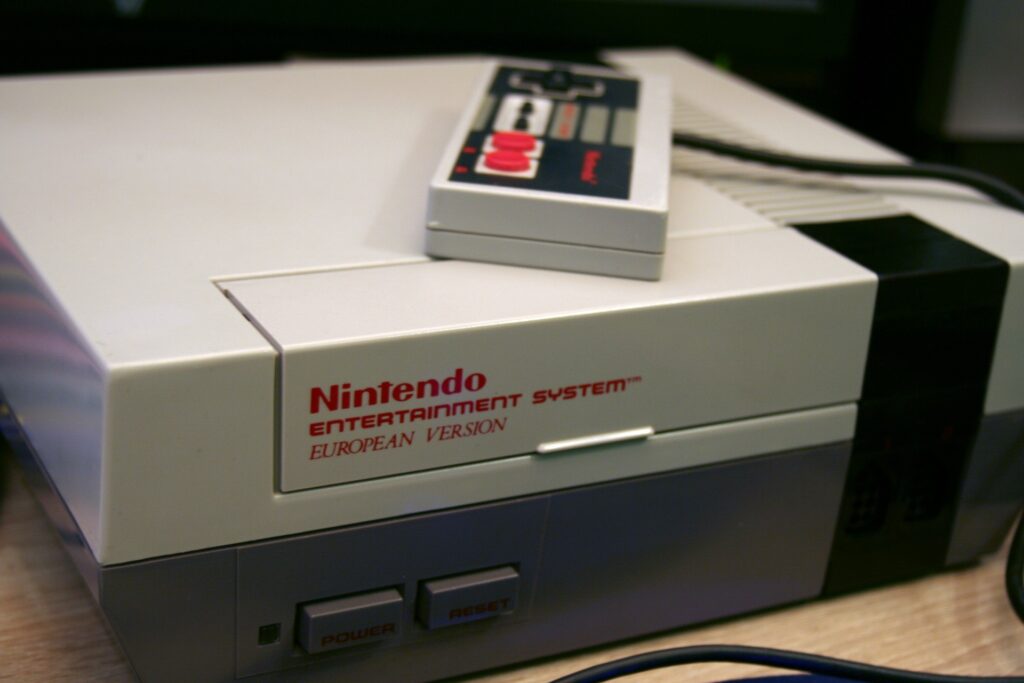
This is a self-explanatory and obvious first step. We are not going online and buying everything that sounds retro (although that is a legitimate approach for some).
This step will probably jump-start those healthy nostalgia feelings, as you will be going down memory lane until your first console and then go back from there, little by little.
I suggest making a spreadsheet. Add headers for console and game name and start filling.
Likely, you won’t remember some of the games’ exact names, but that’s ok. For those, just add a couple more columns stating the year you remember yourself playing it and describe what you remember the game was about.
In the end, something like this would do:
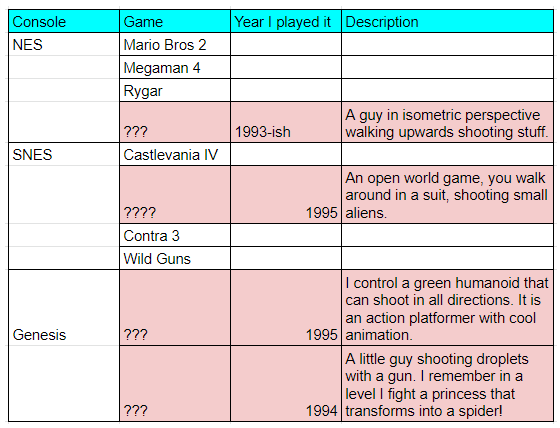
Can you guess the games with the “???” shown in the image? Make sure you mention them in the comments!
Add as many details as you like, and once you finish, you will be ready for the next step.
Can’t Remember Your Games? We Got You Covered.
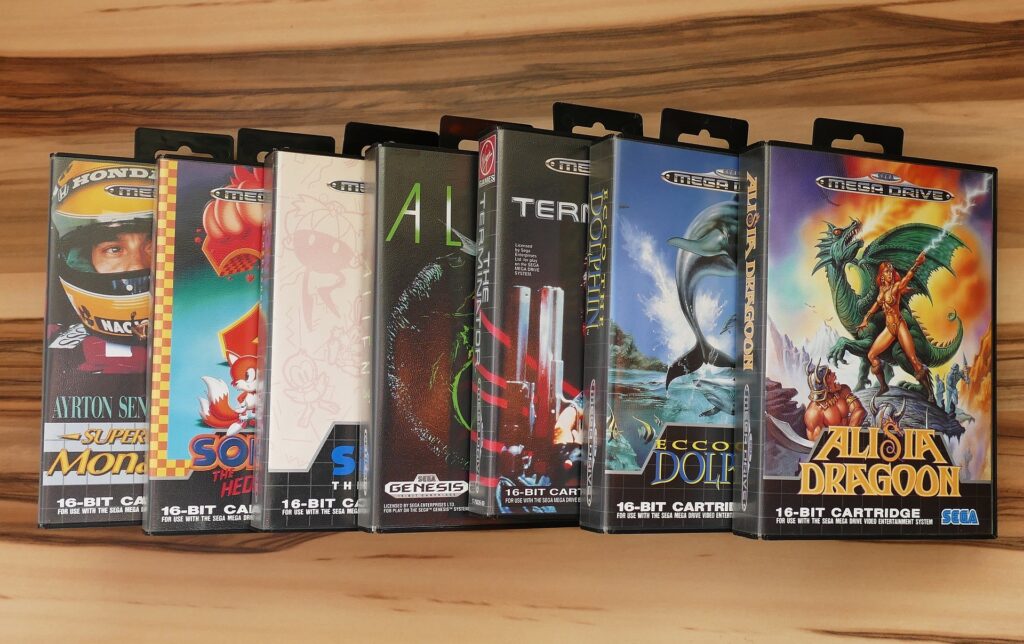
Ok, so now we need to fill the question mark fields using those notes we wrote in our spreadsheet.
This step involves a bit of research, but don’t worry; here are some things you can consider to find those names.
- Use game-specific search engines.
Many online services allow you to search for games with great sensibility and precision for keywords.
Most of these websites have extensive databases of retro video games for every console that ever existed, so your game will most likely be there.
- Good old Wikipedia.
This one is for those who have the patience to go through long lists. Search in Wikipedia for all the games released for a given console, and start looking for your game.
It is not easy to sort the results, but you can always use your browser search function to highlight the genre of your missing game (platformer, fighting, RPG?).
- Retro Game Forums
Happily, we are not the only ones who want to buy retro games. There are countless threads of public forums filled with people helping each other remember the games.
You can search the forums or post a thread yourself describing your game.
Make sure you put every detail you remember; our spreadsheet data will come in handy.
Also, in your way out, check if you can give back some help to a fellow gamer in need!
- Explore Game Walkthroughs
This is one I have used successfully. You can snipe your target game by visiting walkthrough websites.
The rationale behind this is that walkthroughs explain games with great detail, so we will probably hit descriptive keywords better.
Who knows? Maybe besides finding your game, you end up discovering a couple of secrets you missed about it!
- Use image search
While looking for your game, also check the image section of the search results. Sometimes our memory is more visual. We will remember more easily by seeing screenshots of our game instead of written descriptions.
Hopefully, with these tips, you will have your final list of retro games ready to go for the hunt.
Now the final step, we need to get those games in your hands!
Where To Buy Retro Games Nowadays?
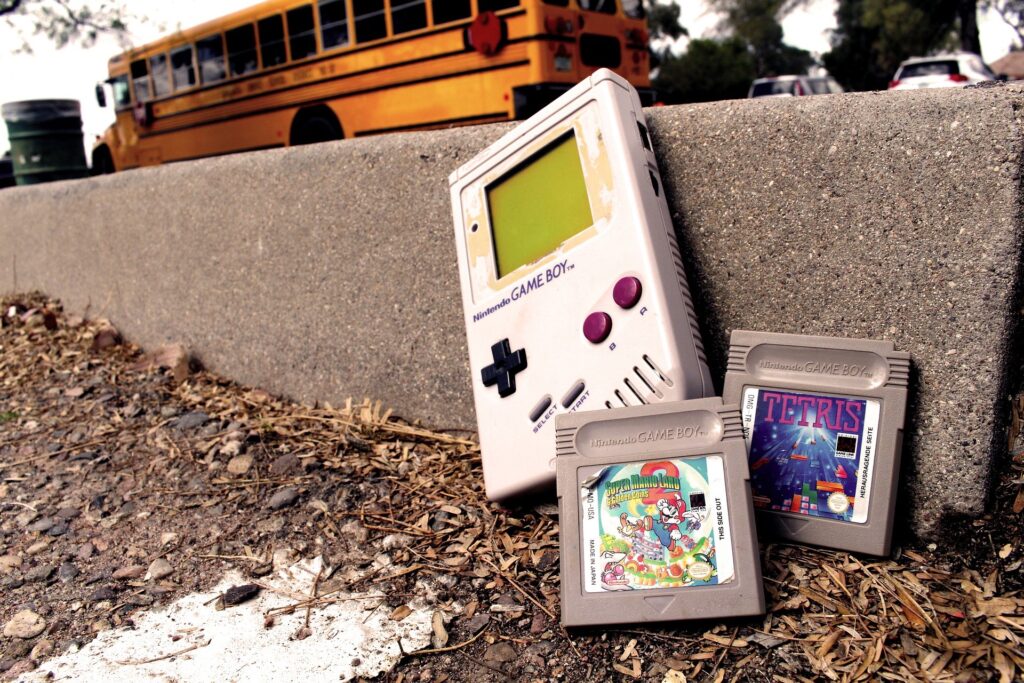
I know you may feel the impulse to just google your game names and buy them in the first place you see.
But there is some key detail we need to keep in mind: these electronic devices were created decades ago. After all, some of them are even shown in museums.
Of course, the retro game market is plagued with damaged cartridges and consoles, completely nonfunctional controllers, and even counterfeited items!
So let me prepare you with a quick cheat sheet to ensure everything goes smoothly.
Market Places vs. Retrogame Stores
When deciding where to get your games, the number of options may be intimidating. However, we can boil them down to two types of sources:
First, there are the marketplaces, where people just sign up and start selling their products. You will find there for people that just want to get rid of things they don’t use to professional retailers.
And second, web stores that belong to a business owner who dedicates to curate and sell games as a way of living.
In my experience, marketplaces are perfectly fine for common items. Still, I don’t think they are the best choice for getting delicate hardware that is 25+ years old.
I resorted to a specialized retro game store to get back my collection, ran by people like you and me: passionate retro gamers!
That surely narrows it down, but still, we need to do some cherry-picking. For that, I recommend you to follow these recommendations.
Check Out Store Reputation
Shopping on the internet is satisfying. You just make a couple of clicks, and things are delivered to you.
But these boons come with risks. As gamers, we know good and evil exist, so we need to be wary of scammers.
We all have the right to feel safe when expending our hard-earned money, so taking additional steps to verify a business’s legitimacy is justified.
When doing this evaluation, I look at two things.
First, I check if the store website has any contact information. You should be way off any store that does not include ways to call, visit, or somehow communicate with its owners.
True retro game stores will have excellent customer service and will answer all your questions promptly.
The second thing I look at is if past customers left any feedback about their store experience. If you see other people leaving positive comments, then everything should be fine.
Comparing Prices
This is a no brainer, as no matter how happy those games will make you, there is no point if you end up broke afterward!
Here, dedicated stores get the nod as well, as their sales thresholds tend to be very low. So low, they are not required to collect sales tax, which usually means lower prices.
Communicate with the store owner, and make sure you check for special offers, bundles, and discounts!
Dodging Counterfeit
Recently, there has been a surge in interest for retro games. The market keeps gaining adepts, and with this, bad people will always try to take advantage.
Fake retro games are a gigantic and lucrative black market. With advancements in technology, it is not that hard to make a lesser quality, functional copy of a given game.
Add that some games are very rare and expensive, and you have a sure-fire formula for cheaters and ill-intentioned hustlers.
Market places are the most prone to harbor these unofficial versions of the games and consoles, and they do very little to avoid this. They take action in a reactive manner; this is after you have already been scammed.
So, unless you have a hawk-eye to detect fake video games, this is another reason to stay away from them and stick to the dedicated retro game stores.
Make Sure Games And Consoles Are Tested
Great, we chose a retro video game store with a good reputation that offers good prices, protecting you against counterfeit.
But, as I mentioned several times, we are buying old stuff.
So, it is of paramount importance those games and consoles to be fully tested and guaranteed by the seller.
This is something that makes it or breaks it for me. No matter how good the store is, if they don’t put the effort to test every game and inspect their integrity and conservation status, I will not give them my money.
The stores usually let you know on their website whether or not the games and consoles they provide are tested, so make sure you read them carefully.
Of course, there is always the possibility of asking for reassurance and the store policies.
You did it! Your games are now on your hands! What now?
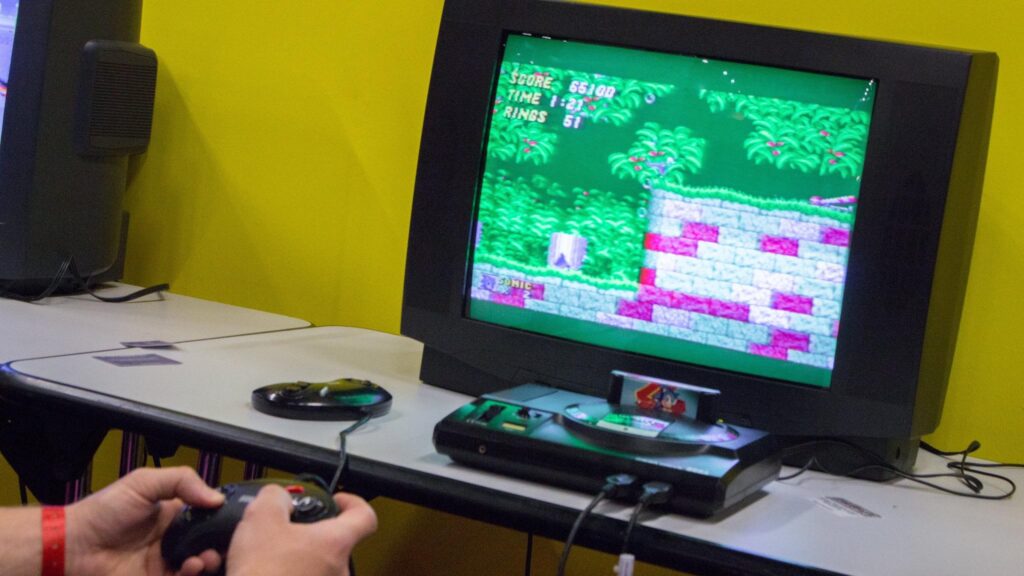
The first thing you need to care about is protecting your investment.
Find a suitable place to store your precious games, a dry place without dust and out of the reach of children, or pets, or your mom (trust me on this one).
I bought a nice shelf to place the consoles and the games, so that is maybe your way to go.
You may also want to learn some tips and tricks to keep your retro gaming collection clean and functional.
Learn to clean the cartridges.
Most retro games are based on cartridges that fit into a crease in your console. Both ends need to make good contact, so the pins need to be checked and cleaned regularly.
I am pretty sure that at some point, you blew air inside the cartridge with your mouth. I did it, too, as we all believed that myth that it would help remove particles and make the game work.
Truth is, we always did more harm than good and probably shortened our cartridges life span.
This is what you do:
- Find appropriate tools to open the cartridges without damaging the carcass or the screws. There are some cheap screwdriver options you can use.
- Use a cotton swab dabbed in alcohol to clean the contacts. Be gentle, and make sure the cotton doesn’t leave any particles. Normal pharmacy alcohol will do (70% Isopropanol, if you like the nerdy terms)
- Use a regular white eraser to, well, erase the dirt away. Rub gently the contact pins a few times. They will be shining like new!
Operate your devices carefully.
Cleaning your games goes a long way when it comes to keeping your consoles dust and dirt free.
But the way you manipulate them will have a great impact on its lifespan.
Do not force the cartridges in. Make sure the slide with minimum pressure. Otherwise, the pins will loosen, and good contact will be harder to achieve.
Location, location, location. Operate your consoles in a place where dust can’t reach them, as not only can they get dusty while in storage, but also while you are using them.
Concluding Remarks
I hope after reading this, you have a clear idea of what you need to care about when restoring your retro game collection.
Games are a beautiful thing. They give us a unique sense of joy, and we made friends and deep connections through them.
We were inspired by their stories and amazed by their clever gameplay and design.
We are blessed to belong to the generation that saw true household gaming born.
Do not let those memories fade. Go, get all your retro video games back.